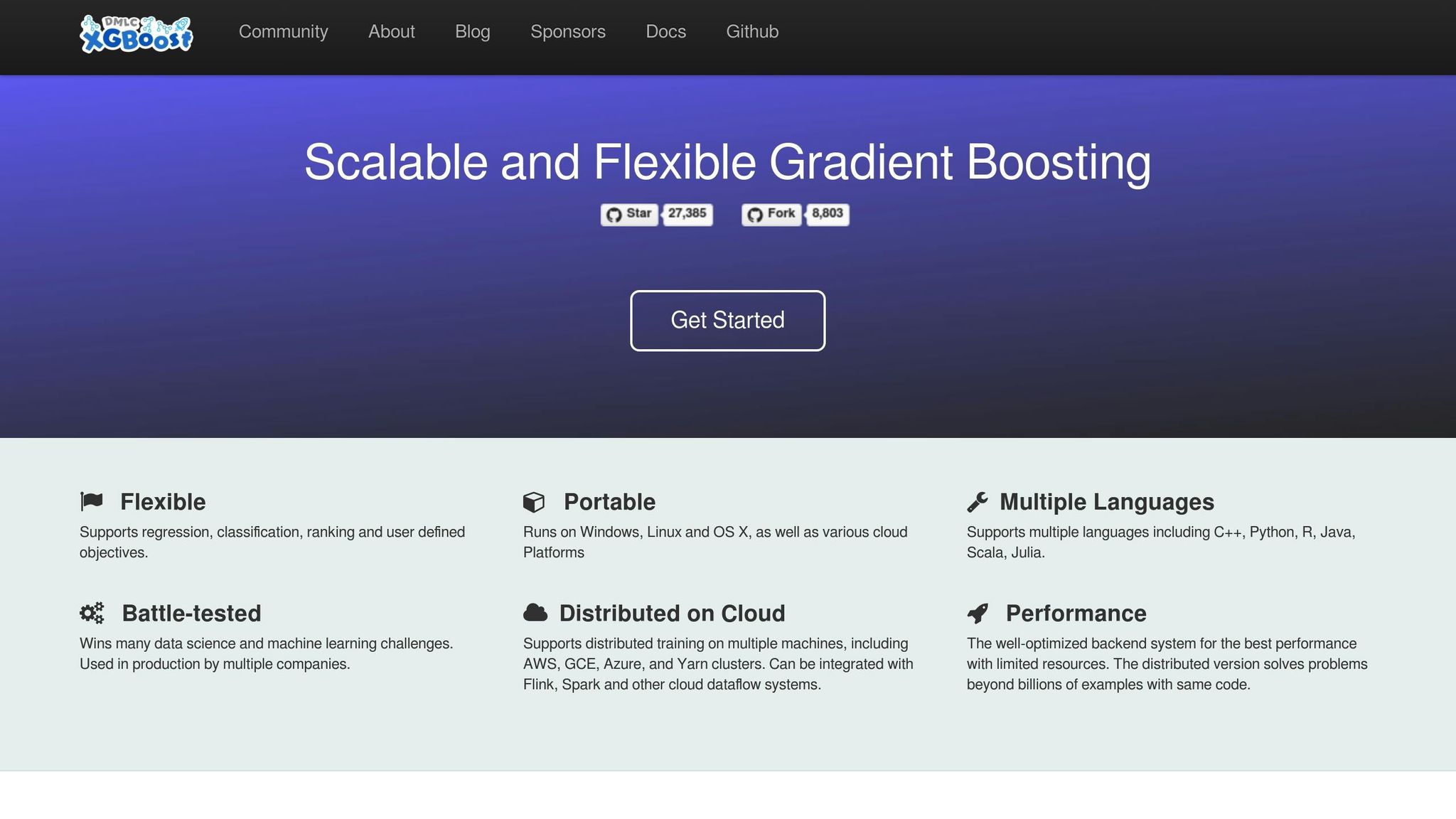Cryptocurrency forecasting is about predicting price trends for assets like Bitcoin and Ethereum using historical data, market indicators, and external factors. It's not about exact price predictions but recognizing patterns to inform trading and investment decisions. Here's what you need to know:
- Challenges: Crypto markets are volatile, influenced by sentiment (e.g., tweets, news), lack traditional valuation metrics, and are affected by blockchain-specific events like network upgrades.
- Data Types: Key inputs include price/volume data, technical indicators, on-chain metrics, market microstructure data, external news, and derivatives data.
- Machine Learning Models: From simple linear regression to advanced tools like XGBoost and LSTM, each model has strengths and weaknesses. Combining models often yields better results.
- Evaluation: Metrics like MAE, RMSE, and directional accuracy help measure model performance. Backtesting and cross-validation ensure reliability.
- Practical Use: Models are used for trading signals, portfolio management, and risk assessment. AI tools and platforms streamline the process, especially for U.S.-based users needing compliance with local standards.
Crypto forecasting is complex but offers opportunities when approached with the right tools, data, and evaluation methods.
Seminar Title: Review of deep learning models for crypto price prediction
Machine Learning Basics for Crypto Forecasting
Machine learning turns raw cryptocurrency data into predictions that can guide decision-making, even in the face of fast-changing market dynamics.
At its core, successful crypto forecasting depends on understanding how machine learning algorithms identify patterns in historical data. These models go beyond simple price charts - they dig into the relationships between variables, like how trading volume might influence price changes or how social media sentiment can sway market trends. Let’s break down the key data types that fuel these predictions.
Supervised learning forms the backbone of most crypto forecasting efforts. It uses labeled historical data - such as past prices, trading volumes, and technical indicators - to train models that can predict future outcomes. Once trained, the model applies what it has learned to current market conditions to forecast potential scenarios.
Time series analysis plays a critical role in crypto forecasting because cryptocurrency prices are sequential and heavily influenced by their immediate past. Unlike traditional machine learning models that assume data points are independent, time series models are tailored for temporal dependencies. For example, a Bitcoin price at 3:00 PM is closely tied to its price at 2:59 PM. These patterns are where specialized models shine. With this foundation, let’s explore the diverse data types that feed these algorithms.
Key Data Types for Crypto Forecasting
Crypto forecasting relies on pulling in data from multiple sources to capture a complete picture of market behavior. Here are the most crucial types:
- Price and volume data: This includes OHLC (open, high, low, close) prices, trading volumes, and bid-ask spreads from various exchanges. These metrics are fundamental for spotting patterns in market activity.
- Technical indicators: Tools like moving averages, Relative Strength Index (RSI), Bollinger Bands, and MACD are derived from price data. They help identify shifts in momentum and potential reversal points, offering a deeper understanding of market conditions.
- On-chain metrics: These provide insights unique to cryptocurrencies. Metrics like active wallet addresses, transaction counts, network hash rates, and token holder distributions reveal the health and adoption of blockchain networks. For instance, tracking the number of Bitcoin addresses holding over 1 BTC or the percentage of supply untouched for a year can highlight long-term trends.
- Market microstructure data: This focuses on how trades occur. Order book depth, trade sizes, and transaction frequency help models understand liquidity and price impact. For example, large trades or sudden order book changes often signal significant price movements.
- External data sources: Factors like news sentiment, social media activity, and regulatory announcements can cause rapid market reactions. Additionally, as crypto markets increasingly align with traditional assets, data like stock market trends, exchange rates, and commodity prices are becoming more relevant.
- Derivatives data: Futures and options markets reveal market sentiment and expectations. Metrics like funding rates, open interest, and options skew show whether traders are leaning bullish or bearish. High funding rates in perpetual futures, for example, often hint at overleveraged positions that could trigger liquidations.
Data Preprocessing Steps
For machine learning models to work effectively, raw crypto data must go through preprocessing. Crypto markets present unique challenges, from data inconsistencies across exchanges to extreme volatility. Here’s how these challenges are addressed:
- Data cleaning: Crypto data often comes from exchanges with varying trading pairs, decimal precision, or even occasional downtime. Cleaning ensures the data is consistent and reliable.
- Timestamp alignment: When combining data from multiple sources, aligning timestamps is essential. For example, on-chain data updates every block, while price data might update continuously. Aggregating or interpolating data to a common interval (like hourly or daily) ensures consistency.
- Outlier detection: Crypto markets are known for their wild price swings. While a 50% price jump might be normal during a bull run, some spikes could result from technical glitches or errors. Preprocessing needs to separate legitimate movements from anomalies.
- Feature engineering: This step transforms raw data into useful inputs for models. Examples include calculating percentage changes instead of absolute price differences, creating rolling averages (e.g., 7-day or 30-day), and generating normalized ratios to account for varying price levels across cryptocurrencies.
- Normalization and scaling: Features often have different units and scales. For instance, Bitcoin prices in the thousands shouldn’t overshadow indicators like RSI. Techniques like min-max scaling (0-1 range) or z-score normalization (centered around zero) help balance these differences.
- Handling missing data: Crypto markets run 24/7, but data gaps can still occur due to technical issues or exchange maintenance. Simple methods like forward-filling may not suffice during volatile periods, so more advanced techniques like interpolation or model-based imputation are often used.
- Lag feature creation: Since crypto prices depend on their past behavior, creating lag features is crucial. For example, tracking price changes across 1-hour, 6-hour, 24-hour, and 7-day intervals allows models to capture both short-term momentum and long-term trends.
Popular Machine Learning Models for Crypto Forecasting
Selecting the right model is crucial for achieving accurate cryptocurrency predictions. Each model offers its own strengths, ranging from straightforward interpretation to advanced pattern recognition. Understanding how and when to apply these models is key to creating effective forecasting systems.
The spectrum of crypto forecasting tools spans traditional statistical methods to cutting-edge deep learning techniques. While no single model is perfect for every scenario, some have consistently shown strong results in navigating the unique complexities of cryptocurrency markets.
Linear Regression and Random Forest
Linear regression is a foundational tool in forecasting, prized for its simplicity and clarity. It works by identifying relationships between input features - like trading volume, market sentiment, or technical indicators - and price movements. The model assumes these relationships are linear, providing a clear view of how each factor influences predictions.
One of the biggest advantages of linear regression is its transparency. For instance, you can directly see how a 10% increase in trading volume might correspond to a 2% rise in price. This makes it a valuable tool for understanding market dynamics, even though it may not always deliver the most precise predictions.
However, crypto markets are rarely linear. Bitcoin, for example, often experiences exponential growth phases followed by steep corrections - patterns that linear regression struggles to capture. Additionally, the model assumes that relationships between variables remain constant over time, which isn’t always true in the fast-changing crypto world.
Random Forest offers a more robust alternative by combining multiple decision trees into a single predictive model. Each tree analyzes a different aspect of the data, and their collective output often results in more accurate predictions.
Random Forest is particularly effective at handling non-linear relationships and interactions between features. For example, it can recognize that high trading volume combined with positive sentiment creates a stronger bullish signal than either factor alone. Its ensemble approach also reduces the risk of overfitting, which is critical in volatile markets like crypto. Plus, it handles missing data well and requires minimal preprocessing.
While these traditional models are effective, advanced tools are better equipped to tackle the complexities of cryptocurrency markets.
Advanced Models: XGBoost and LSTM

As market dynamics grow more intricate, models must evolve to capture these complexities. XGBoost (Extreme Gradient Boosting) takes prediction accuracy to the next level by building decision trees sequentially. Each tree learns from the errors of its predecessors, leading to continuous refinement.
XGBoost thrives in scenarios with rich datasets that include price trends, technical indicators, on-chain metrics, and external factors. Its gradient boosting mechanism uncovers intricate patterns and interactions that might elude human analysis. Additionally, its built-in regularization helps prevent overfitting, which is particularly valuable when dealing with limited historical data for newer cryptocurrencies.
LSTM (Long Short-Term Memory) networks, on the other hand, are tailor-made for time series data. Unlike traditional models that treat each data point independently, LSTMs remember important patterns from the past while ignoring irrelevant details.
This memory capability allows LSTMs to capture long-term dependencies in price movements. For example, they can recognize that a trading pattern from three weeks ago might still influence today’s price, even if the market behaved differently in between. LSTMs are particularly effective for short-term forecasting, as they can identify daily or even hourly trends.
However, LSTMs require large amounts of data and significant computational power to train effectively. They also function as black boxes, offering little transparency into how predictions are made.
Hybrid Models and NLP-Based Forecasting
Combining different models often leads to better results. Hybrid models leverage the strengths of multiple approaches to create more comprehensive forecasting systems. For instance, an LSTM might analyze temporal patterns while XGBoost evaluates fundamental indicators. Together, they provide a more complete market analysis.
Another hybrid strategy involves combining technical analysis with sentiment analysis. A technical model like Random Forest or XGBoost might focus on price patterns, while a sentiment model analyzes news articles, social media, and regulatory updates to gauge market mood.
Sentiment analysis, powered by NLP (Natural Language Processing) models, plays an increasingly important role in crypto forecasting. Tools like BERT (Bidirectional Encoder Representations from Transformers) can analyze the tone and context of news, tweets, and forum discussions to predict market reactions.
These NLP models can differentiate between various types of news. For example, a regulatory announcement from the SEC carries a different weight than a celebrity tweet. They can also detect subtle shifts in sentiment that might signal upcoming price movements.
GPT-based models take this a step further by understanding the relationships between events and market responses. They can process earnings reports, partnership announcements, and technical updates to assess their potential impact on specific cryptocurrencies.
The primary advantage of NLP-based forecasting is its ability to analyze real-time information that hasn’t yet influenced market prices. While technical models rely on historical data, NLP models can react to breaking news and emerging trends as they unfold.
sbb-itb-212c9ea
How to Evaluate and Compare Machine Learning Models
Creating forecasting models is just the start. The real test is figuring out if your model can handle the unpredictable nature of crypto markets and how it measures up against other models. Without proper evaluation, a model that looks good in theory might fail when put to the test in live trading.
Crypto markets are especially tricky to evaluate. Unlike traditional financial markets, cryptocurrencies operate 24/7 and can experience sudden volatility spikes. These conditions can make months of training data irrelevant in an instant. Your evaluation framework needs to reflect these unique challenges.
Key Performance Metrics
When it comes to evaluating models, a few key metrics stand out:
- Mean Absolute Error (MAE): This metric shows the average difference between predicted and actual prices. For instance, if your Bitcoin model has an MAE of $500, it means predictions are typically off by about $500. MAE is straightforward and treats all errors equally, making it a good fit for crypto, where you want a clear picture of overall prediction accuracy.
- Root Mean Squared Error (RMSE): RMSE gives more weight to larger errors by squaring them before averaging. For example, a $2,000 error impacts the score four times more than a $1,000 error. This makes RMSE useful for crypto, where missing big price swings can be costly. However, it can be skewed if your dataset includes extreme outliers.
- R-squared: This measures how well your model explains price changes compared to simply using the average price. In crypto, an R-squared value between 0.4 and 0.6 can still indicate decent performance, even though traditional finance might consider higher values better. Crypto’s volatility means perfection isn’t realistic.
- Directional accuracy: This metric focuses on whether your model correctly predicts price movements - up or down - rather than exact prices. Even if a model isn’t perfectly precise, a 65% directional accuracy can still be profitable in trading, where trend direction often matters more than exact numbers.
Backtesting and Cross-Validation
To ensure your model is reliable, you need to test it rigorously. Here are some methods:
- Walk-forward analysis: This approach respects the time sequence of your data. You train your model on historical data, test it on the next period, and then move the window forward to repeat the process. This mimics real-world conditions, where only past data is available to predict the future. It’s particularly helpful in spotting models that perform well in one market phase but falter in another.
- Time series cross-validation: This method builds on walk-forward analysis by creating overlapping training and testing periods. It provides more robust performance estimates while still preserving the order of the data.
- Out-of-sample testing: Save the most recent 10–20% of your data as a final test set. This ensures your model is evaluated on completely unseen data, simulating real-world deployment. Avoid the temptation to peek at these results during development, as it compromises the integrity of the test. Many models that seem promising fail this step, exposing overfitting issues.
These testing methods not only validate a model’s performance but also provide a clear basis for comparing different models.
Model Comparison
Each model type has its strengths and weaknesses. Here’s a quick breakdown to help you decide which one fits your needs:
| Model Type | Strengths | Weaknesses | Best Use Cases |
|---|---|---|---|
| Linear Regression | Easy to understand, quick to train, low computational needs | Assumes linear relationships, struggles with volatility | Baseline comparisons, identifying market drivers |
| Random Forest | Handles non-linear patterns, resistant to outliers | Limited memory of past events, prone to overfitting with small datasets | Medium-term forecasting, analyzing feature importance |
| XGBoost | High accuracy, manages complex interactions, built-in regularization | Computationally demanding, requires careful parameter tuning | High-accuracy tasks, working with rich datasets |
| LSTM | Excellent for sequences, captures long-term dependencies | Requires large datasets, slow training, less transparent | Short-term predictions, recognizing patterns |
| Hybrid Models | Combines strengths of multiple models, highly flexible | Complex to build and maintain, difficult to debug | Advanced trading systems, in-depth analysis |
Practical considerations like computational and data requirements often play a big role in model selection. Linear regression and Random Forest models are lightweight, training quickly on standard hardware. On the other hand, LSTMs may need GPU acceleration and hours of training. If frequent retraining is required, simpler models might be more practical.
Data availability is another factor. Linear regression can work with smaller datasets, while LSTMs need thousands of examples to avoid overfitting. For newer cryptocurrencies with limited historical data, simpler models might again be a better choice.
Finally, interpretability matters, especially when money is on the line. Models like linear regression and Random Forest provide clear insights into which factors drive predictions. This transparency helps identify issues and explain results to stakeholders. In contrast, LSTM and hybrid models, while powerful, function more like black boxes, making them harder to troubleshoot.
Many successful forecasting systems use ensemble approaches that combine multiple models. For example, you might average predictions from XGBoost and LSTM, or assign weights to models based on recent performance. This strategy spreads risk and ensures that no single model’s failure derails your overall forecast.
Real-World Applications and AI Tools for Crypto Forecasting
Implementing forecasting systems in real-world scenarios often reveals challenges that don’t show up in controlled environments. Factors like data delays and sudden market shifts can disrupt even the most well-tested models.
Implementing Forecasting Models
Trading platforms use machine learning (ML) models to generate buy and sell signals, often relying on ensemble methods for better accuracy. Portfolio management apps assess how cryptocurrencies interact with traditional assets to establish risk boundaries, while risk management tools use forecasts to set position limits and stop-loss levels.
To stay effective in ever-changing markets, these models depend on strong data pipelines and regular updates. The frequency of these updates varies by application. For instance, high-frequency trading systems might update several times a day, while long-term strategies might only require weekly or monthly updates. The key is finding the right balance - keeping models current without letting short-term noise distort their effectiveness.
This practical approach to integration lays the groundwork for using specialized tools to improve forecasting accuracy.
Using AI Apps for Crypto Forecasting

AI Apps offers a centralized hub with over 1,000 AI tools tailored for crypto forecasting. Users can quickly find and compare tools based on technical features or budget constraints. Advanced filters make it easy to narrow down options by category or pricing model, helping analysts and developers identify applications suited to financial analysis and forecasting tasks.
The platform also highlights newly launched and featured tools, ensuring users stay updated on the latest advancements. This streamlined process saves time, allowing professionals to integrate proven AI tools into their workflows without wading through endless research.
However, selecting the right tools is just part of the equation. U.S. users, in particular, need to account for compliance and localization requirements.
Considerations for U.S. Users
In the U.S., crypto forecasting tools and platforms must adhere to specific standards. Prices should be displayed in USD (e.g., $45,123.67), dates should follow the MM/DD/YYYY format, and user interfaces should reflect Eastern Time (ET), while calculations typically rely on UTC.
Regulations also require detailed documentation of model decisions, performance metrics, and risk management practices for compliance and tax purposes. The IRS mandates accurate records, including transaction dates, amounts, and market values, for tax reporting. Additionally, some organizations prefer tools that ensure sensitive financial data is stored on U.S.-based servers to meet data residency requirements.
Conclusion
Cryptocurrency forecasting pushes the boundaries of machine learning in finance, but combining the right models can significantly improve prediction accuracy. For beginners, simpler methods like linear regression or random forest can provide a solid starting point. Meanwhile, more advanced techniques are better equipped to handle the unique challenges posed by the crypto market.
It's important to remember that no single model is perfect for every market condition. Ensemble approaches, combined with rigorous backtesting across varied market cycles, tend to deliver more reliable results than relying on any one model alone. However, even the most advanced models can struggle during unpredictable events, such as regulatory changes or exchange hacks.
This underscores the importance of robust data pipelines and thorough testing. Clean, well-preprocessed data often outperforms noisy data, even when used in simpler models. So, prioritize data quality over chasing complex architectures.
Platforms like AI Apps offer a streamlined way to explore forecasting tools, with over 1,000 curated options. Their filtering system makes it easy to find tools that align with specific technical needs and budget constraints.
For U.S.-based practitioners, selecting tools that automatically address local compliance and documentation requirements - such as tax reporting and data residency standards - can save time and ensure regulatory alignment.
When evaluating models, focus on long-term reliability. A model achieving 85% accuracy over six months of historical data is far more trustworthy than one boasting 95% accuracy over just two weeks. Always validate predictions across multiple market cycles before making financial decisions.
The crypto forecasting space is constantly evolving, with new methods emerging all the time. By mastering the basics and staying open to advancements, you can unlock the full potential of cryptocurrency forecasting.
FAQs
How do machine learning models enhance cryptocurrency price predictions?
Machine learning models are transforming cryptocurrency price predictions by uncovering complex patterns and trends within massive datasets. Techniques like LSTM (Long Short-Term Memory) and GRU (Gated Recurrent Unit) neural networks are particularly well-suited for analyzing time-series data, making them powerful tools for navigating the unpredictable nature of cryptocurrency markets.
These models can sift through extensive historical data, revealing connections that conventional methods often overlook. By adjusting to shifts in market behavior, they deliver predictions that are both precise and dependable, giving investors and analysts the insights they need to make smarter decisions.
What are the essential steps to prepare data for accurate cryptocurrency forecasting?
Preparing data for cryptocurrency forecasting requires a series of important steps to ensure the results are accurate and dependable. First, data cleaning is essential. This process addresses errors, fills in any gaps in the data, and eliminates inconsistencies that could skew predictions. Next comes data transformation, which includes methods like normalization and scaling to prepare the data for machine learning models by standardizing its features.
Another critical step is feature extraction, where meaningful indicators - such as moving averages or measures of volatility - are derived from the raw data to provide valuable insights. Data integration then brings together information from various sources to create a more comprehensive dataset. Finally, dimensionality reduction trims down the dataset by removing redundant or less relevant features, simplifying it without losing critical information. Together, these steps ensure the data is clean, consistent, and ready to train effective forecasting models.
How do hybrid models and NLP-based techniques improve cryptocurrency forecasting?
Hybrid models are changing the game in cryptocurrency forecasting by merging traditional statistical tools with cutting-edge machine learning techniques, including deep learning. This blend doesn’t just sharpen long-term predictions - it also uncovers subtle patterns in price behavior that might otherwise go unnoticed.
On top of that, NLP-based methods take forecasting to the next level. By analyzing text data from sources like social media and news articles, these models can measure market sentiment and emotional trends. This insight allows traders to pick up on key market signals. Advanced language models, which dive deeper than basic dictionary-based methods, consistently deliver more precise predictions, making them an essential asset for building smarter trading strategies.



